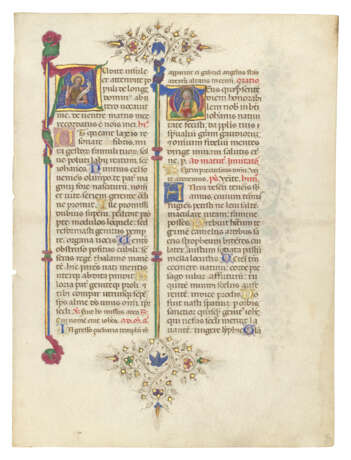ID 1105622
Lot 15 | Matteo de' Pasti (1420-1468)
Estimate value
£ 7 000 – 10 000
A bifolium with three historiated initials from the Breviary of Lionello d'Este, illuminated manuscript on vellum [Ferrara, c.1441-1448]
A wonderful example of the best of 15th-century Ferrarese illumination. A splendid and richly decorated bifolium from a lavish manuscript originally made for Lionello d’Este, Marquis of Ferrara and Duke of Modena and Reggio Emilia from 1441 to 1450.
275 x 203mm. Two separate leaves forming a bifolium of non-consecutive text, two columns of 30 lines written in brown ink in a gothic bookhand, the text from the Feast of St Boniface and the Nativity of John the Baptist: 'Audite insule et attendite' to 'eius apud te [...]', the first leaf with catchword 'd[omi]no', rubrics in red, 9 two-line illuminated initials, full-length bar borders of burnished gold terminating with floral and sprays, 3 five-line historiated initials depicting St John the Baptist and Zacharias on the recto of the first leaf; a younger John the Baptist on the verso (light marginal thumbing and dampstaining, else in excellent condition).
Provenance:
(1) All aspects of the manuscript – size, format and illumination – correspond to those of the Missal of Borso d'Este, marquis and then duke of Ferrara (Modena, Biblioteca Estense, Ms W.5.2, lat. 239) and the Breviary was certainly made either for him or his predecessor Lionello, and intended, like the Missal, for use in the ruler’s chapel. It is now usually identified with the Breviary recorded in accounts in the d’Este archives as having been illuminated for Lionello by Giorgio d’Alemagna, Bartolomeo di Benincà, Guglielmo Giraldi and Matteo de' Pasti.
(2) The parent manuscript was sold at Christie’s, 8 December 1958, lot 190, as part of the estate of the 2nd Baron Llangattock. It carried the bookplate of John Etherington Welch Rolls (1807-1870), father of the 1st Baron Llangattock. Many miniatures had already been removed (supposedly by soldiers during the Peninsular War) and after the sale the remaining leaves were separated and dispersed. Sister leaves were sold recently at Christie’s 30 July 2020, lot 3; and 5-19 October 2023, lots 205 and 206.
(3) This bifolium sold at Sotheby's, 21 July 1994, lot 62 and subsequently:
(4) Christie's, 24 November - 3 December 2015, lot 27.
Illumination:
The Breviary, a masterpiece of Ferrarese illumination, was written by Francesco de Codigoro, with Giorgio d’Alemagna as its principal illuminator, but in 1443, because of the enormity of the project, Giorgio enlisted the help of Bartolomeo de Benincà, Matteo de’ Pasti (a pupil of Pisanello) and Guglielmo Giraldi. The three miniatures in our bifolium are the work of Matteo de' Pasti, illuminator, artist, architect and medallist who worked for the Malatesta and Visconti families. The most comprehensive recent study of the Breviary is F. Toniolo, ‘Il lungo viaggio del Breviario di Lionello d'Este tra le due sponde dell'Atlantico’, Medioevo: arte e storia, 2008, pp.564-77 (see also Toniolo in Les Enluminures du Louvre, 2011, no 45). A virtual reconstruction of the manuscript can be found on the 'Broken Books' website (brokenbooks.omeka.net), where the present leaves are listed.
| Address of auction |
CHRISTIE'S 8 King Street, St. James's SW1Y 6QT London United Kingdom | ||||
|---|---|---|---|---|---|
| Preview |
| ||||
| Phone | +44 (0)20 7839 9060 | ||||
| Buyer Premium | see on Website | ||||
| Conditions of purchase | Conditions of purchase |





